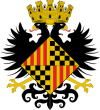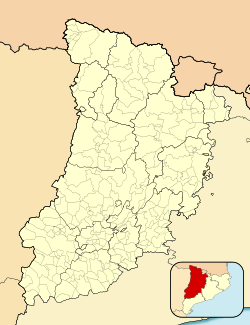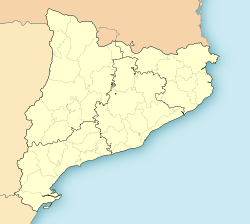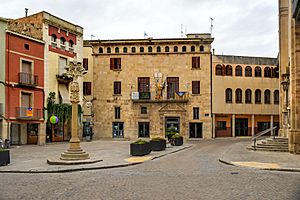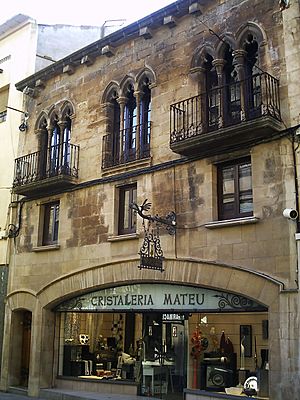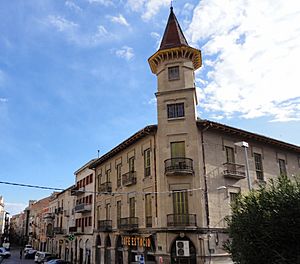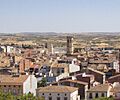Tàrrega facts for kids
Quick facts for kids
Tàrrega
|
|||
|---|---|---|---|
|
Municipality
|
|||
| Tàrrega | |||
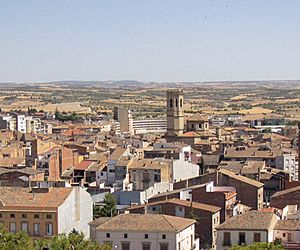
Tarrega with the tower of the Santa Maria de l'Alba de Tàrrega visible
|
|||
|
|||
| Country | |||
| Autonomous community | |||
| Province | |||
| Comarca | |||
| Area | |||
| • Total | 88.4 km2 (34.1 sq mi) | ||
| Elevation | 373 m (1,224 ft) | ||
| Population
(2018)
|
|||
| • Total | 16,795 | ||
| • Density | 189.99/km2 (492.07/sq mi) | ||
| Demonym(s) | targarí, targarina | ||
| Time zone | UTC+1 (CET) | ||
| • Summer (DST) | UTC+2 (CEST) | ||
| Postal code |
25300
|
||
| Official language(s) | Spanish and Catalan | ||
| Climate | Cfa | ||
Tàrrega is a town and a municipality in Catalonia, Spain. It is located in the Urgell area, which is part of the Province of Lleida. A municipality is like a local government area, and a comarca is a traditional region in Catalonia. In 2020, about 17,445 people lived in Tàrrega.
The town has a climate that is mostly Mediterranean. This means it has warm, dry summers and mild, wet winters. There are also some influences from a Continental climate, which means it can have bigger temperature differences between summer and winter.
One popular spot is a park on Sant Eloi mountain. This mountain is about 420 meters (1,378 feet) high. The park has a beautiful old church from the 13th century, built in the Romanesque style. Tàrrega is also famous for its theatre fair. This fair happens every September and brings in over 100,000 visitors each year!
Contents
History of Tàrrega
Tàrrega started to grow a lot in the 11th century. This happened after Count Ramon Berenguer I took control of its castle. The town was in a very important spot where many roads met. Because of this, Tàrrega became a significant place for trade and land ownership in the medieval times.
During this period, Tàrrega was a lively town. It had a strong Jewish community and busy fairs and markets. Many skilled workers, especially goldsmiths, lived and worked there. However, this time of growth ended sadly with the Black Death. This terrible sickness caused many people to die, and the town became much less populated.
In 1348, the Jewish people of Tàrrega faced a very difficult and violent time. Many Jewish people were killed during this period. Later, in 2007, people found what might have been the old Jewish cemetery. Digs there showed that many people buried in shared graves had died violently.
After the Black Death, Tàrrega started building strong walls. This was because people were worried about fights between powerful lords. From the 16th to the 19th centuries, Tàrrega became more like a farming area. Rich local families had a lot of control. The town also faced many wars and local conflicts during these centuries, which made things unstable.
In the second half of the 19th century, Tàrrega began to thrive again. Many important things happened then. A railway line opened in 1860, connecting the town to Manresa and Lleida. The town walls were rebuilt after a flood in 1874. In 1884, King Alfonso XII gave Tàrrega the special title of "city." During this time, the city also got modern things like better roads and services.
Exploring Tàrrega's Geography
The center of Tàrrega is built around a main square called Carme Square. Most people know it as "the Courtyard" (el Pati). In the square, you can see a statue of Ramon Carnicer. He was a famous composer from Tàrrega.
Right next to the square is the Convent of Carme. This building has a beautiful Renaissance style cloister, which is an open walkway, and it was built in the 16th century. Other important buildings in the square include the town council building, which was built in 1674. There's also the modernist chamber of commerce building from the 19th century and the La Caixa savings bank from 1910.
Other interesting places in Tàrrega include the museum on the main street. This museum still has some fancy rooms from the 18th and 19th centuries. You can also visit the church of Saint Anthony (Sant Antoni). It is in a square with the same name and dates back to the 14th century.
If you go higher up, you can find the old ruins of the castle of Count Ramon Berenguer. This castle was built in 1056, but not much of it is left today.
The municipality of Tàrrega also includes several smaller villages. These are El Talladell, Claravalls, Altet, Santa Maria de Montmagastrell, La Figuerosa, Riudovelles, and Conill (which is now abandoned).
Famous People from Tàrrega
- Mossèn Azà, a poet
- Joan Capdevila, a footballer
- Ramon Carnicer, a Catalan composer
- Alfonso Costafreda, a poet
- Francesc Marsà Figueras, a painter
- Josep Güell i Guillaumet, a musician
- Josep Minguell, a painter
- Manuel de Pedrolo, a Catalan author
- Anton Tartera, a painter
Images for kids
See also
 In Spanish: Tárrega para niños
In Spanish: Tárrega para niños



